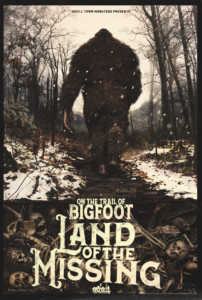
On the Trail of Bigfoot: Land of the Missing (2023)
Directed and Written By: Seth Breedlove
Starring: Seth Breedlove, Alexander Petakov, et al

In the newest Small Town Monsters production, director and writer Seth Breedlove examines Bigfoot legends from a true-crime angle, marrying disappearances in Alaska to local Sasquatch stories. In doing so, the documentary attempts to infuse fresh fear into well-worn folklore, with varying degrees of success.
Sasquatch. Yeti. Bigfoot. Whatever you call them, they’re probably the world’s most recognizable cryptid: the giant, hairy ape committed to written records as early as 1721 in the United States.
Native American and First Nations lore depicting mysterious and often bloodthirsty forest apes is far older, with stories and art dating back many hundreds of years; even the word “Sasquatch” comes from a First Nations language in what is now British Columbia. These stories are particularly prevalent in the Pacific Northwest, where a recent podcast was set. Meanwhile, Land of the Missing takes the Bigfoot search to Alaska.
There’s great horror territory to be mined from Alaska, whose state slogan is “The Last Frontier.” Its remote landscapes, sparsely-populated towns, often-violent weather, and imposing fauna have lent atmosphere to films including 30 Days of Night, The Grey, and The Last Winter. Yet in our current era, Bigfoot as a cultural fixture seems at odds with anything that might prompt, in the words of one of Breedlove’s interviewees, “instant dread.” Bigfoot is on bumper stickers, park signs, beer cans. Bigfoots (Bigfeet?) feature as insurance spokescryptids and hang out with Chuck E. Cheese.
To be sure, B-horror is bursting with Bigfoot–such vividly-titled fare as Shriek of the Mutilated and Creature from Black Lake show the elusive ape as a force to be reckoned with. But the Bigfoot of Harry and the Hendersons or everyone’s favorite Dana Scully windbreaker moment “The Jersey Devil” (let’s be real, this is a Bigfoot episode of The X-Files, not the Jersey Devil) is the prevailing image of Sasquatch stateside. He’s just a guy! A hairy, cuddly guy who likes chilling in the woods and wants to be left alone. He’s even in your kid’s media; books like Cryptid Club and Bigfoot and Nessie: The Art of Getting Noticed are big with the elementary school crowd right now.
With Land of the Missing, Breedlove and company try to bring Bigfoot back to his origins. In somewhat of a red herring, the documentary begins this attempt with reference to Christopher McCandless, the backpacker who died in 1992 near Denali National Park and became the subject of the Jon Krakauer book Into the Wild. The average person, familiar with Krakauer’s book or its film adaptation, would see no connection between McCandless and Bigfoot legends. There’s not much mystery to McCandless’s death, and since his remains were found, he cannot even be classed with the other subjects of Land of the Missing: a reel of people disappearing over the years from remote Alaskan locales. But from another angle, McCandless is in line with the documentary’s ultimate portrait of Bigfoot as a figure thoroughly colonized by dominant American culture.

Land of the Missing features the standard documentary array of talking heads, their stories and theories a bit undercut by lack of attribution–their names appear, but no indication of professional background or amateur expertise to indicate why they’re being interviewed.
To some extent, this seems appropriate, as a few of the interviewees are Native Alaskans speaking of their own cultures’ lore. Breedlove’s stated intention is to situate popular Bigfoot legends more firmly in their Native origins, and details deviating from typical Bigfoot tropes are highlighted. In Alaska, Bigfoot-type monsters lead people astray, into deep forest, mountain terrain, or storms. Furthermore, certain forest sounds–baby cries, whistles–are to be avoided, as they portend violence from a Sasquatch. The oldest Native and First Nations stories within Alaska, Yukon, and British Columbia delineate women and children as the likeliest Bigfoot prey. Women and children are, in general, the most vulnerable members of any given society; Native women in particular are subject to higher rates of disappearance, trafficking, assault, and murder than Canadian and US national averages.
One of horror’s archetypal functions is to provide an answer for unanswerable questions. Land of the Missing zeroes in on the ghost town Portlock as evidence of a settlement terrorized by Bigfoot. It posits the more frightening, baleful Bigfoot of Native legend as possible reasoning behind a preponderance of missing women.
Which comes first: the societal need to keep women and children within their community, or the monster which kidnaps women and children? In this mode, the documentary is most successful at moving Bigfoot into that mode of instant dread. Although the CG Bigfoots throughout the movie are in the usual style of giant, human-like hairy apes, the real-world scenery of Alaska’s mountains and woods give the art elements extra gravitas.
Set against his natural backdrop–the stories and myths of Native people–Bigfoot reverts to a more primal figure than the plush-toy version most viewers know best. Yet Land of the Missing also falls prey to a common tendency in paranormal documentaries. There’s a muddling that often occurs, wherein mention of one legend leads inevitably to all the other ones. Different-but-related monster stories, such as those of ice giants or gnomic apes, might have a place in a Bigfoot doc; UFOs and the so-called Black Pyramid don’t. The seriousness with which the film treats Native traditions and very real missing-persons cases is at odds with more typical Ancient Aliens-esque fare sprinkled throughout.

Ultimately, Land of the Missing is getting at something other cryptid concepts may downplay. Bigfoot is so completely entrenched in white American culture that he seems invented from whole cloth alongside Mickey Mouse. In this way, he’s been defanged, his origins sidelined or determinedly ignored to benefit monster hunters and beer companies alike.
And in this way, the film’s throughline returns to Christopher McCandless. A self-styled adventurer longing to explore uncharted country, he dispensed with maps when it became clear that their reality (a comprehensively-charted Alaska) was at odds with his desire. American pop culture has dispensed with Bigfoot’s map, both the historical map reaching back through Native lifetimes and the sociological map that connects mythical monsters to real-world violence against women and children. Only his outline remains, a cipher.
On the Trail of Bigfoot: Land of the Missing is now streaming on iTunes, Vudu, and FandangoNow, and available for Blu-Ray purchase. The author of this article received a review copy courtesy of Small Town Monsters and Justin Cook. Film posters and still images courtesy of Justin Cook.

![[NEWS] ‘CRYPTIDS’ PODCAST LANDS ON DARK MATTER TV WITH VISUAL EXPERIENCE](https://www.dis-member.com/wp-content/uploads/2021/01/0-150x150.jpg)
![[BIRTHDAY] THANK YOU TIM BURTON FOR SHARING YOUR ECCENTRIC GENIUS WITH US](https://www.dis-member.com/wp-content/uploads/2019/08/MV5BMGViMmM4MTUtZjRiMi00ZjEwLThjOTQtODYyNzQyZDc4ODRkXkEyXkFqcGdeQXVyNDQxNjcxNQ@@._V1_-150x150.jpg)
![[BOOK REVIEW] ‘DEATH COMES TOO LATE’ IS A TENSE COLLECTION OF TREATS](https://www.dis-member.com/wp-content/uploads/2024/05/51QM2UQbagL-150x150.jpg)


Average Rating